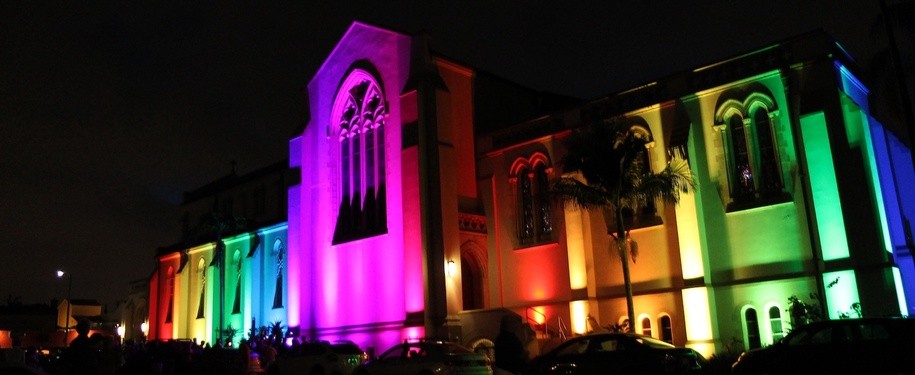
As the Senate works to codify the right of same sex couples to marry, it might be worth looking at what the Bible has to say about gays and gay marriage. What it really says (and doesn’t say) might surprise you.
Let’s start with the story of the Centurion.
It’s one of the most famous stories from the Bible. After gaining a much-deserved reputation as a miracle healer, Jesus entered a fishing village with his followers, where he was greeted by a Roman Centurion. Like many of the people who approached the Jewish teacher and healer, the Centurion had a loved one with a health problem he wanted Jesus to fix. In this case, that loved one was his beloved male servant, who was paralyzed and suffering.
Jesus offered to visit the Centurion’s home. But the Centurion responded that Jesus didn’t need to:
“Lord, I do not deserve to have you come under my roof. But just say the word. For I myself am a man under authority, with soldiers under me. I tell this one, ‘Go,’ and he goes; and that one, ‘Come,’ and he comes. I say to my servant, ‘Do this,’ and he does it.” (Luke).
The passage is famous because it showed that the Centurion understood that Jesus did not need to visit someone in the flesh to heal them. What also makes the passage notable is that, in all likelihood, the Centurion was gay and his male servant was his Number One lover.
The Roman Emperor Augustus had instituted a ban on straight marriage for all serving Roman soldiers, a ban that predated the birth of Christ and lasted all the way to AD 197. Saying that a man was a Centurion at this point in Rome was basically saying that the man was gay. It was a well known fact that these men routinely had sexual relationships with their male servants.
Did Jesus tell him to “sin no more” or criticize the Centurion in any way? Just the opposite. Jesus told the crowd watching him interact with the Roman: “I tell you, I have not found such great faith even in Israel.” The interaction is captured beautifully in the 1977 TV movie “Jesus of Nazareth”, with the role of the Centurion played by none other than Ernest Borgnine (husband of gay icon Ethel Mermen, a coincidence no doubt).
Truth is, gay male relationships were so common in the Roman Empire, even among “straight” male Romans with families, that the idea that this Centurion was not dating his beloved servant doesn’t just seem unlikely, but actually implausible.
Readers over a thousand years ago would no doubt have assumed the Centurion was gay. This interpretation may help explain why, centuries later, an icon from St. Catherine’s monastery on Mt. Sinai was created depicting two gay Roman men marrying — with the figure of Jesus effectively serving as Best Man at the wedding.
The icon features the image of two Roman soldiers — St. Serge and St. Bacchus, who became Christian martyrs in the early years of the Church. A 10th Century Greek account of these two Romans describes their relationship as decidedly gay. St. Serge was the “erastai” (Greek for lover) of St Bacchus. The feast day of these martyred saints is October 7.

So if the early church was at least OK enough with homosexuality that it was implicitly celebrated between two saints, when and why did this stance change to what it was in the 20th century?
Interpretations changed. In fact, a documentary coming out this year highlights the fact that the word “homosexual” didn’t even appear in translations of the Bible until the year 1946.
It took over a thousand years for the Church to go from embracing same-sex civil unions to burning gays alive. According to Derrick S. Bailey’s 1955 history Homosexuality and the Western Christian Tradition, gay relationships were initially forbidden among monks and clergy, as part of their discipline, and it wasn’t until the Middle Ages that the prohibition was expanded to include “laymen” — i.e., the common folk.
In the 1200s, Thomas Aquinas had written about homosexuality and condemned it and by the 1400s others had joined in with Bernardino of Siena preaching for three straight days against homosexuality in Florence, Italy.
By the Spanish Inquisition, hundreds of gays were being tried, convicted and burned alive.
But much of what appears in the Bible that anti-gay zealots point to as proof of God’s “hatred” of homosexuality is questionable today just as it was then. It’s similar to the content that American and European slave traders took out of context in the Bible to justify the human rights abuses of the African slave trade. It was up to Quakers, Christian abolitionists, and others to read and interpret what the Bible really taught about slavery: That it was against God. While slave traders misquoted the Bible to justify their industry (and even outright censored Bibles that were distributed in the American South), genuine Christians led the effort to eradicate slavery on the Earth.
Denominations such as the Episcopal Church honor same-sex marriages and more denominations should join them. It’s the perfect time to do it, just as the Respect for Marriage Act is set to codify equal marriage in America law (against any executive order changes or supreme court reversals the future might bring).








